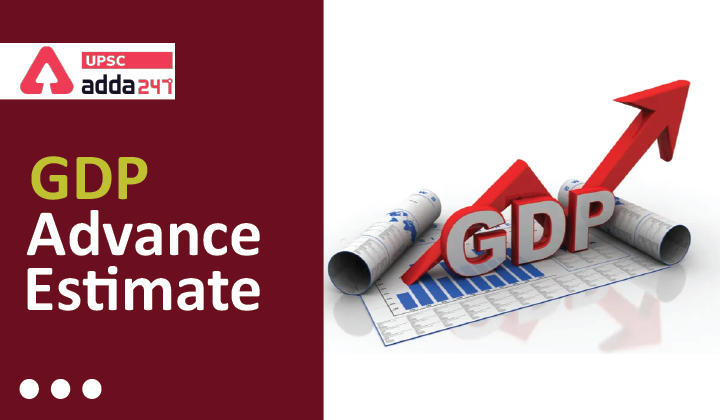Table of Contents
Context
Releasing the first advance estimates of National Income for 2021-22, the NSO stated, “The growth in real GDP during 2021-22 is estimated at 9.2 per cent as compared to the contraction of 7.3 per cent in 2020-21.”
What are the First Advance Estimates of GDP?
- The FAE was first introduced in 2016-17.
- They are typically published at the end of the first week of January.
- They are the “first” official estimates of how GDP is expected to grow in that financial year.
- They are also the “advance” estimates because they are published long before the financial year (April to March) is over.
- Although the FAE are published soon after the end of the third quarter (October, November, December), they do not include the formal Q3 GDP data, which is published at the end of February as part of the Second Advance Estimates (SAE).
What is the significance of FAE?
- Since the SAE will be published next month, the main significance of FAE lies in the fact that they are the GDP estimates that the Union Finance Ministry uses to decide the next financial year’s budget allocations.
- Because nominal GDP is the actually observed variable. Real GDP, which is the GDP after taking away the effect of inflation, is a derived metric. That’s why Budget calculations start with the nominal GDP.
- From the Budget-making perspective, it is important to note what has happened to nominal GDP — both absolute level and its growth rate.
- Real GDP = Nominal GDP — Inflation Rate
- However, from the perspective of the common people, real GDP is what matters. The difference between the real and nominal GDP shows the levels of inflation in the year.
How is the FAE arrived at before the end of the concerned financial year?
- The FAE are derived by extrapolating the available data. According to the MoSPI, the approach for compiling the Advance Estimates is based on the Benchmark-Indicator method i.e. “the estimates available for the previous year (2020-21 in this case) are extrapolated using relevant indicators reflecting the performance of sectors.”
- For instance, for these FAE, the MoSPI has extrapolated sector-wise estimates using indicators such as Index of Industrial Production (IIP) up to October, inflation — both retail and wholesale — data up to November, sale of commercial vehicles data up to September, so on and so forth.
About GVA
- While the GDP maps the economy from the expenditure (or demand) side — that is by adding up all the expenditures, the GVA provides a picture of the economy from the supply side. GVA maps the “value-added” by different sectors of the economy such as agriculture, industry and services.
- As things stand, aggregate GDP in FY22 is estimated to cross the pre-Covid level. This also holds true for the absolute level of Gross Value Added (GVA).
About NSO
- In pursuance to the decisions of the Union Cabinet on 19.05.2005, the Government, through its resolution dated 01.06.2005, decided to set up the National Statistical Commission.
- It also decided to merge the Central Statistical Organisation (CSO) and National Sample Survey Organisation (NSSO) into a single entity called the National Statistical Organisation (NSO).
- It Compiles and releases the Index of Industrial Production (IIP) every month in the form of ‘quick estimates’; conducts the Annual Survey of Industries (ASI); and provides statistical information to assess and evaluate the changes in the growth, composition and structure of the organised manufacturing sector.
What are the Key Observations?
Real GDP Growth: At 9.2%, the real GDP growth rate for FY22 is slightly lower than most expectations, including RBI’s, which pegged it at 9.5%. What’s more, these estimates are based on data before the rise of the Omicron variant. As such, there is a possibility that the final rate may be revised further downwards by May-end when the full financial year’s “provisional” estimates will be published. However, in times of such massive upheavals, it is always better to look at the absolute levels instead of growth rates.
Role of High Inflation: For FY22, while real GDP (that is, GDP calculated using constant 2011-12 prices) will grow by 9.2%, nominal GDP (that is GDP calculated using current market prices) will grow by a whopping 17.6%. The difference between the two growth rates — about 8.5 percentage points — is essentially a marker of inflation (or the rate at which average prices have increased in this financial year).
Low Private Consumption: An analysis of the three main contributors to GDP — private consumption demand, investments in the economy, and government expenditures — shows that while the latter two are expected to claw back to the pre-Covid level, the first engine will continue to stay in a slump. Private consumption expenditures typically account for more than 55% of all GDP.



 TSPSC Group 1 Question Paper 2024, Downl...
TSPSC Group 1 Question Paper 2024, Downl...
 TSPSC Group 1 Answer key 2024 Out, Downl...
TSPSC Group 1 Answer key 2024 Out, Downl...
 UPSC Prelims 2024 Question Paper, Downlo...
UPSC Prelims 2024 Question Paper, Downlo...
